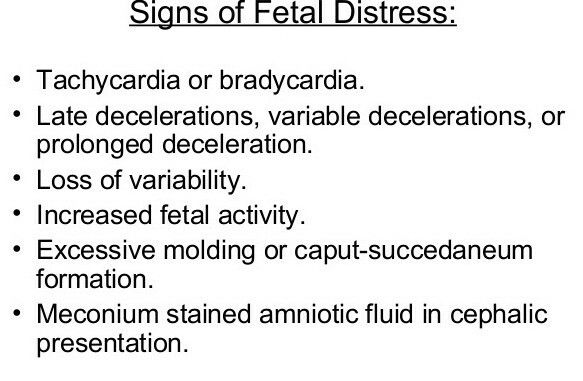Recognizing Fetal Distress: A Parent’s Guide to Understanding the Signs
Hey there, amazing future parents! ? Are you ready to embark on the exciting journey of parenthood? Part of the adventure is ensuring that your little one is happy and healthy even before they make their grand entrance into the world. Understanding fetal distress signs can be super important for monitoring your baby’s well-being. So let’s dive into the sea of knowledge and make sure you’re equipped to recognize any signals that your baby might need some extra care!
What is Fetal Distress?
Fetal distress – it might sound a bit scary, but don’t worry! It’s just a term used by doctors to indicate that your baby may not be doing as well as we’d like inside the womb. It can happen due to various reasons, like if your little one isn’t getting enough oxygen, or if there’s some hiccup with the umbilical cord. Knowledge is power, and knowing what to look for is the best way to stay one hop ahead!
Understanding the Signs of Fetal Distress
When it comes to fetal distress, there are several signs that can pop up during pregnancy or delivery that you should be aware of. Detecting them early can make a world of difference, so keep those peepers peeled for:
- Decreased fetal movement: If your baby starts to feel less like a tiny dancer and more like a quiet observer, it could be a sign that something is up. A decrease in kicks or movement should always be checked out by your doctor.
- Abnormal fetal heart rate: Your healthcare provider will listen to your baby’s heartbeat at check-ups, and they’re looking to hear a strong, steady rhythm. Too fast or too slow can signal stress in your baby’s comfy cocoon.
- Meconium in the amniotic fluid: If your water breaks and you notice a greenish tinge, it could mean your baby has passed meconium – their first poop – while still inside. It happens, no judgment! But it might indicate distress and needs to be addressed posthaste.
- Cramping and back pain: Some cramping and back pain can be normal, but intense pain that doesn’t go away could signify a problem like placental abruption. Definitely not a time for guesswork – call your doctor if you’re experiencing this.
It’s super important to recognize that every pregnancy is as unique as a fingerprint, and there’s no one-size-fits-all scenario. If you ever feel that something just isn’t right, trust your instincts and reach out to your healthcare provider. After all, you know your body and your baby best!
Monitoring Fetal Health
Regular check-ups are a fabulous way to keep tabs on your baby’s health. During prenatal visits, your healthcare professional will monitor your baby’s growth and heart rate, check the level of amniotic fluid, and look at their overall development through ultrasounds. It’s your peephole into the womb to ensure your pint-sized partner in crime is thriving!
When to Seek Medical Attention
If you notice any unusual symptoms or changes, it’s better to be safe than sorry! Always contact your healthcare provider if you experience:
- Severe or persistent abdominal pain or back pain
- Decreased fetal movement, especially after 28 weeks
- Fluid leaking from the vagina (indicating possible premature rupture of membranes)
- Any bleeding or spotting
- A sudden swell in the face or hands (could be a sign of preeclampsia)
These symptoms don’t automatically mean your baby is in distress, but they do warrant a check-in with your doctor to make sure everything is going smoothly. Keep those communication lines open!
Now that we’ve covered the basic signs of fetal distress, in our next segment, we’ll delve deeper into the causes and how healthcare providers address these concerns. Stay tuned for more empowering knowledge as we continue our guide to keep your baby bounding and bouncing on the path to a healthy birth.
Together, we’ll make sure you feel like the super-parents you’re meant to be, ready to meet and greet your little one with all the joy in the world. So stay positive, stay informed, and remember that you’ve got this! Keep shining, brilliant beings! ?

5 Vital Things Parents Should Know in Preparing for Fetal Distress Signs
As you navigate through the waves of your pregnancy voyage, it’s essential to arm yourself with knowledge so you can sail smoothly even if the waters get choppy. Here’s a lifesaver list of 5 important things to prepare you for recognizing and handling fetal distress signs:
1. Education is Key
Knowledge truly is your best friend when it comes to fetal distress. Dive into reliable resources – books, online articles, and educational classes offered by hospitals or birthing centers. Learn about the different types of fetal distress and what leads to them. Knowledge will empower you to identify potential issues promptly, so remember, every bit of learning is a step towards protecting your baby.
2. Knowing Your Baseline
Every baby is unique, and so is their movement pattern. Pay attention to the rhythm of your baby’s kicks and activities. Many doctors recommend keeping a ‘kick count’ in the later stages of your pregnancy. Understanding what’s normal for your little one will help you catch any deviations quickly. So start charting that baby barometer early!
3. Open Communication Lines with Your Healthcare Provider
Never hesitate to ask questions or express concerns during your prenatal visits. A question you may think is small could provide essential information about your baby’s health. When it comes to your baby, there’s no such thing as over-communication. Your healthcare provider can offer reassurance or take appropriate action based on your observations.
4. Stress Management Techniques
Stress can be a sneaky saboteur of both your own health and your baby’s well-being. Practicing relaxation techniques like prenatal yoga, meditation, or deep-breathing exercises can help reduce stress, which in turn, may reduce the risk of fetal distress. Plus, these peaceful practices can also prepare you for a calmer labor and delivery.
5. Preparing a Birth Plan
While you can’t script out your labor and delivery, having a birth plan in place keeps you in the driver’s seat as much as possible. In it, outline your preferences and discuss them with your birthing team. Make sure to address potential scenarios that could indicate fetal distress and confirm strategies and interventions your care team might employ to ensure the best outcome.
Your knowledge and preparation are the anchors that keep you grounded, but remember, it’s perfectly okay to reach out for help. Reach out to your support system – partners, family members, and friends – who can provide extra eyes and ears when needed. Teamwork makes the dream work, after all!
And don’t forget, your healthcare team is as invested in your baby’s birth as you are; they’re the seasoned sailors ready to navigate through any storms. So use these five insights as your compass, and you’ll be charting a course for a healthy, joyful parenting journey.
Next Steps in Addressing Fetal Distress
Once a potential sign of fetal distress has been identified, your healthcare provider can use various tools and tests to evaluate the situation further. These may include non-stress tests (NST), biophysical profiles (BPP), and additional ultrasounds to closely monitor the baby’s heart rate and movements. If distress is confirmed, action can range from close monitoring to interventions like inducing labor or even a cesarean delivery if necessary to ensure the safety and well-being of both mother and baby.
Understanding the signs and knowing how to prepare can make all the difference when it comes to fetal distress. Stay observant, proactive, and ready to act. By doing so, you’ll be nurturing a safe environment for your little one’s arrival. Now, take a deep breath; you’ve got an amazing journey ahead, filled with incredible moments and the invaluable gift of a new life. Keep glowing and growing in confidence, dear parents-to-be!
See more great Things to Do with Kids in New Zealand here. For more information see here
Disclaimer
The articles available via our website provide general information only and we strongly urge readers to exercise caution and conduct their own thorough research and fact-checking. The information presented should not be taken as absolute truth, and, to the maximum extent permitted by law, we will not be held liable for any inaccuracies or errors in the content. It is essential for individuals to independently verify and validate the information before making any decisions or taking any actions based on the articles.




